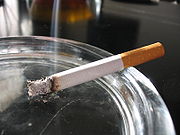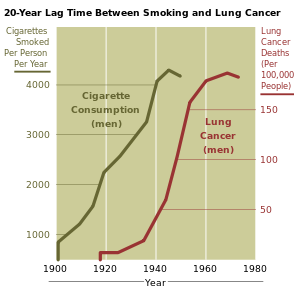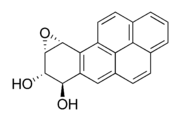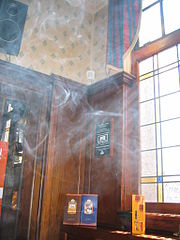
Tobacco smoking
Background Information
SOS Children, an education charity, organised this selection. With SOS Children you can choose to sponsor children in over a hundred countries
Tobacco smoking is the inhalation of smoke from burned dried or cured leaves of the tobacco plant, most often in the form of a cigarette. People may smoke casually for pleasure, habitually to satisfy an addiction to the nicotine present in tobacco and to the act of smoking, or in response to social pressure. In some societies, people smoke for ritualistic purposes. According to the WHO about one-third of the world's male population smokes tobacco, 'with two-thirds of all the world's smokers residing in 10 countries'. In order they are China, India, Indonesia, Russia, the U.S., Japan, Brazil, Bangladesh, Germany and Turkey respectively. (Which is not strange as over two-thirds of the world's population lives in those countries)
Tobacco use by Native Americans throughout North and South America dates back to 2000 BC. The practice was brought back to Europe by the crew of Christopher Columbus. Tobacco smoking took hold in Spain and then was introduced to the rest of the world by trade. Tobacco is an agricultural product processed from the fresh leaves of plants in the genus Nicotiana. Tobacco has been growing on the northern continents since about 6000 BC and began being used by native cultures at about 3000 BC. It has been smoked in one form or another since about 2000 BC. There are pictoral drawings of ancient Mayans smoking crude cigars from 1400 BC.
Tobacco smoke contains nicotine and harmane (a MAO inhibitor), which combined give rise to addictive stimulant and euphoriant properties. The effect of nicotine in first time or irregular users is an increase in alertness and memory, and mild euphoria. Nicotine also disturbs metabolism and suppresses appetite. This is because nicotine, like many stimulants, temporarily increases blood sugar levels.
Medical research has determined that tobacco smoking causes lung cancer, emphysema, and cardiovascular disease among other health problems. The World Health Organization reported that tobacco smoking killed 100 million people worldwide in the 20th century and warned that it could kill one billion people around the world in the 21st century.
Methods of smoking
Cigarette
Cigarette smoking is the most common form of tobacco consumption. Because of the curing process, the smoke is mild enough to inhale in overdose quantities, unlike cigar, roll-your-own or pipe tobacco. Cigarettes also contain a number of additives, particularly to enhance taste. Cigarettes are smoked by some with a cigarette holder. (See also Beedi).
Roll-Your-Own
Roll-Your-Owns, often called rolleys or roll ups, are very popular, particularly in European countries; these are prepared from loose tobacco, cigarette papers and filters all bought separately.
Cigar
A cigar is generally puffed, not inhaled. Cigars come in many shapes and sizes, the most common being the "Corona", "Cigarillo", and "Robusto". The tobacco used is grown throughout the Caribbean in places such as the Dominican Republic, Nicaragua, Honduras, Jamaica, and Cuba, but also in countries in other regions such as Brazil and Indonesia. Cigars generally come available in 2 categories in reference to colour, "Natural" and "Maduro". "Natural" shades are ones that do not undergo a further fermenting process, unlike "Maduro" which in its construction involves a further fermenting process to darken and strengthen (in taste) the leaf.
Pipe
A pipe for smoking typically consists of a small chamber (bowl) for combustion of the substance to be smoked and a thin stem (shank) that ends in a mouthpiece (also called a bit). Pipes are made from a variety of materials (some obscure): briar, corncob, meerschaum, clay, wood, glass, gourd, bamboo, and various other materials, such as metal. Tobacco used for smoking pipes is often chemically treated to change smell and taste not available in other commercial tobacco products. Many of these are mixtures using staple ingredients of variously cured Burley and Virginia tobaccos which are mixed with tobaccos from different areas, such as Oriental or Balkan locations. Latakia (a fire-cured tobacco of Cypriot or Syrian origin), Perique (only grown in St. James Parish, Louisiana) or combinations of Virginia and Burley tobaccos of African, Indian, or South American origins. Traditionally, many U.S. tobaccos are made of American Burley with artificial sweeteners and flavorings added to create an artificial "aromatic" smell, whereas "English" blends are based on natural Virginia tobaccos enhanced with Oriental and other natural tobaccos. There is a growing tendency towards "natural" tobaccos which derive their aromas from blending with spice tobaccos alone and historically-based curing processes.
Pipes can range from the simple machine-made briar pipe to handmade and artful implements created by pipe-makers which can be expensive collectors' items. The popularity of pipe smoking in Western countries has declined in recent years under the onslaught of cigarette advertising. However, it has also enjoyed a resurgence of late among younger and middle aged smokers who find its contemplative nature and age-transcendent status as "hobby not habit" to be both thoroughly enjoyable and stress-relieving. As many pipe-smokers say, "We don't inhale."
Hookah
A hookah (or sheesha) is a type of traditional Middle Eastern and South Asian water pipe, which operates by water-filtration and indirect heat. Hookahs are most popular in the Middle East, but form a niche market in many other places. In other contexts, hookahs are used to smoke cannabis, hashish or opium.
Typically, tobacco is smoked from a hookah by placing richly flavored tobaccos in the smoking bowl, covering it with foil, and placing a coal on top of the foil. This keeps the tobacco from burning, and allows it to bake. The resulting vapors are further cooled by the hookah water and filtered by a bubbling action in the basin of the hookah, resulting in a moist, warm light smoke. The Al-Waha, Al Fakher, and Nakhla tobacco companies compete for market share in the Middle East by producing flavored tobaccos for use in the hookah. Some flavors include the traditional apple, grape, double apple, orange, strawberry, cherry, mango, vanilla, and melon flavors; as well as more modern flavours of cola, coconut, cappuccino, and banana milk.
Health effects
Establishing a link between smoking and health effects
As the use of tobacco became popular in Europe, a number of people became concerned about its negative effects. One of the first was King James I of Great Britain. In his 1604 treatise, A Counterblaste to Tobacco, King James observed that smoking was:
A custome lothsome to the eye, hatefull to the Nose, harmfull to the braine, dangerous to the Lungs, and in the blacke stinking fume thereof, nearest resembling the horrible Stigian smoke of the pit that is bottomelesse.
The late-19th century invention of automated cigarette-making machinery in the American South made possible mass production of cigarettes at low cost, and cigarettes became elegant and fashionable among society men as the Victorian era gave way to the Edwardian. In 1912, American Dr. Isaac Adler was the first to strongly suggest that lung cancer is related to smoking. In 1929, Fritz Lickint of Dresden, Germany, published a formal statistical evidence of a lung cancer–tobacco link, based on a study showing that lung cancer sufferers were likely to be smokers. Lickint also argued that tobacco use was the best way to explain the fact that lung cancer struck men four or five times more often than women (since women smoked much less).
Prior to World War I, lung cancer was considered to be a rare disease, which most physicians would never see during their career. With the postwar rise in popularity of cigarette smoking, however, came a virtual epidemic of lung cancer.
In 1950, Richard Doll published research in the British Medical Journal showing a close link between smoking and lung cancer. Four years later, in 1954 the British Doctors Study, a study of some 40 thousand doctors over 20 years, confirmed the suggestion, based on which the government issued advice that smoking and lung cancer rates were related. The British Doctors Study lasted till 2001, with result published every ten years and final results published in 2004 by Doll and Richard Peto. Much early research was also done by Dr. Ochsner. Reader's Digest magazine for many years published frequent anti-smoking articles. In 1964 the United States Surgeon General's Report on Smoking and Health (referenced below), led millions of American smokers to quit, the banning of certain advertising, and the requirement of warning labels on tobacco products.
Health risks of smoking
The main health risks in tobacco pertain to diseases of the cardiovascular system, in particular myocardial infarction (heart attack), cardiovascular disease, diseases of the respiratory tract such as Chronic Obstructive Pulmonary Disease (COPD), asthma, emphysema, and cancer, particularly lung cancer and cancers of the larynx and tongue.
A person's increased risk of contracting disease is directly proportional to the length of time that a person continues to smoke as well as the amount smoked. However, if someone stops smoking, then these chances gradually decrease as the damage to their body is repaired. A year after quitting, the risk of contracting heart disease is half that of a continuing smoker. The health risks of smoking are not uniform across all smokers. Risks vary according to amount of tobacco smoked, with those who smoke more at greater risk. Light smoking is still a health risk. Likewise, smoking "light" cigarettes does not reduce the risks.
The data regarding smoking to date focuses primarily on cigarette smoking, which increases mortality rates by 40% in those who smoke less than 10 cigarettes a day, by 70% in those who smoke 10–19 a day, by 90% in those who smoke 20–39 a day, and by 120% in those smoking two packs a day or more. Pipe smoking has also been researched and found to increase the risk of various cancers by 33%.
Some studies suggest that hookah smoking is considered to be safer than other forms of smoking. However, water is not effective for removing all relevant toxins, e.g. the carcinogenic aromatic hydrocarbons are not water-soluble. Several negative health effects are linked to hookah smoking and studies indicate that it is likely to be more harmful than cigarettes, due in part to the volume of smoke inhaled. In addition to the cancer risk, there is some risk of infectious disease resulting from pipe sharing, and other risks associated with the common addition of other psychoactive drugs to the tobacco.
Diseases caused by tobacco smoking are significant hazards to public health. According to the Canadian Lung Association, tobacco kills between 40,000–45,000 Canadians per year, more than the total number of deaths from AIDS, traffic accidents, suicide, murder, fires and accidental poisoning. The United States Centers for Disease Control and Prevention describes tobacco use as "the single most important preventable risk to human health in developed countries and an important cause of premature death worldwide."
Carcinogenicity
Smoke, or any partially burnt organic matter, is carcinogenic (cancer-causing). The damage a continuing smoker does to their lungs can take up to 20 years before its physical manifestation in lung cancer. Women began smoking later than men, so the rise in death rate amongst women did not appear until later. The male lung cancer death rate decreased in 1975 — roughly 20 years after the fall in cigarette consumption in men. A fall in consumption in women also began in 1975 but by 1991 had not manifested in a decrease in lung cancer related mortalities amongst women.
Smoke contains several carcinogenic pyrolysis products, particularly the polynuclear aromatic hydrocarbons (PAH), which are toxicated to mutagenic epoxides. The first PAH to be identified as a carcinogen in tobacco smoke was benzopyrene, which been shown to toxicate into a diol epoxide and then permanently attach to nuclear DNA, which may either kill the cell or cause a genetic mutation. If the mutation inhibits programmed cell death, the cell can survive to become a cancer cell.
The carcinogenity of tobacco smoke is not explained by nicotine per se, which is not carcinogenic or mutagenic. However, it inhibits apoptosis, therefore accelerating existing cancers. Also, NNK, a nicotine derivative converted from nicotine, can be carcinogenic. Thus, to reduce cancer risk but to deliver nicotine, there are tobacco products where the tobacco is not pyrolysed, but the nicotine is vaporized with solvent such as glycerol.
Lung dysfunction
Chronic obstructive pulmonary disease (COPD) caused by smoking, known as tobacco disease, is a permanent, incurable reduction of pulmonary capacity characterized by shortness of breath, wheezing, persistent cough with sputum, and damage to the lungs, including emphysema and chronic bronchitis.
Effects on the heart
Smoking contributes to the risk of developing heart disease. All smoke contains very fine particulates that are able to penetrate the alveolar wall into the blood and exert their effects on the heart in a short time.
Inhalation of tobacco smoke causes several immediate responses within the heart and blood vessels. Within one minute the heart rate begins to rise, increasing by as much as 30 percent during the first 10 minutes of smoking. Carbon monoxide in tobacco smoke exerts its negative effects by reducing the blood’s ability to carry oxygen.
Smoking tends to increase blood cholesterol levels. Furthermore, the ratio of high-density lipoprotein (the “good” cholesterol) to low-density lipoprotein (the “bad” cholesterol) tends to be lower in smokers compared to non-smokers. Smoking also raises the levels of fibrinogen and increases platelet production (both involved in blood clotting) which makes the blood viscous. Carbon monoxide binds to haemoglobin (the oxygen-carrying component in red blood cells), resulting in a much stabler complex than haemoglobin bound with oxygen or carbon dioxide -- the result is permanent loss of blood cell functionality. Blood cells are naturally recycled after a certain period of time, allowing for the creation of new, functional erythrocytes. However, if carbon monoxide exposure reaches a certain point before they can be recycled, hypoxia (and later death) occurs. All these factors make smokers more at risk of developing various forms of arteriosclerosis. As the arteriosclerosis progresses, blood flows less easily through rigid and narrowed blood vessels, making the blood more likely to form a thrombosis (clot). Sudden blockage of a blood vessel may lead to an infarction (e.g. stroke). However, it is also worth noting that the effects of smoking on the heart may be more subtle. These conditions may develop gradually given the smoking-healing cycle (the human body heals itself between periods of smoking), and therefore a smoker may develop less significant disorders such as worsening or maintenance of unpleasant dermatological conditions, e.g. eczema, due to reduced blood supply. Smoking also increases blood pressure and weakens blood vessels.
Smoker's attitudes
Nicotine is an addictive stimulant and is one of the main factors leading to continued tobacco smoking. Although the percentage of the nicotine inhaled with tobacco smoke is quite small (most of the substance is destroyed by the heat) it is still sufficient to cause physical and/or psychological dependence.
Prior to habituation, tobacco smokers often focus on the reinforcing properties of smoking rather than the associated health risks. The diseases caused by smoking surface relatively later in life, so they do not serve to deter smoking.
Some smokers argue that the depressant effect of smoking allows them to calm their nerves, often allowing for increased concentration. However, according to the Imperial College London, "Nicotine seems to provide both a stimulant and a depressant effect, and it is likely that the effect it has at any time is determined by the mood of the user, the environment and the circumstances of use. Studies have suggested that low doses have a depressant effect, whilst higher doses have stimulant effect." However, it is impossible to differentiate a drug effect brought on by nicotine use, and the alleviation of nicotine withdrawal.
Passive smoking
Passive or involuntary smoking occurs when the exhaled and ambient smoke (otherwise known as environmental or secondhand smoke) from one person's cigarette is inhaled by other people. Passive smoking involves inhaling carcinogens, as well as other toxic components, that are present in secondhand tobacco smoke.
Secondhand smoke is known to harm children, infants and reproductive health through acute lower respiratory tract illness, asthma induction and exacerbation, chronic respiratory symptoms, middle ear infection, lower birth weight babies, and Sudden Infant Death Syndrome. In a study published on August 25, 2004 smoke-free policies were linked to a short-term reduction in admissions for acute myocardial infarction. In a study released on February 12, 2006 warning signs for cardiovascular disease are higher in people exposed to secondhand tobacco smoke, adding to the link between "passive smoke" and heart disease. "Our study provides further evidence to suggest low-level exposure to secondhand smoke has a clinically important effect on susceptibility to cardiovascular disease," said Dr. Andrea Venn of University of Nottingham in Britain, lead author of the study.
According to the U.S. Surgeon General’s Report ( Chapter 5; pages 180–194), secondhand smoke is connected to SIDS. Infants who die from SIDS tend to have higher concentrations of nicotine and cotinine (a biological marker for secondhand smoke exposure) in their lungs than those who die from other causes. Infants exposed to secondhand smoke after birth are also at a greater risk of SIDS.
A young waitress who had asthma died at her workplace after being exposed to environmental tobacco smoke. While at her workplace she collapsed after about 20 minutes and then died. The autopsy proved that the woman died from acute asthma, which was associated with work-related ETS( environmental tobacco smoke).
According to earlier studies the smoking ban led to significant improvements regarding respiratory symptoms and lung function in people visiting bars and restaurants. Previously scientists stated that environmental tobacco smoke leads to coronary heart disease, lung cancer and premature death.
The case is available in the February edition of the American Journal of Industrial Medicine.
Somatic and psychological effects
Nicotine is a highly addictive psychoactive chemical. When tobacco is smoked, most of the nicotine is pyrolyzed; a dose sufficient to cause mild somatic dependency and mild to strong psychological dependency remains. There is also a formation of harmane (a MAO inhibitor) from the acetaldehyde in cigarette smoke, which seems to play an important role in nicotine addiction probably by facilitating dopamine release in the nucleus accumbens in response to nicotine stimuli. According to studies by Henningfield and Benowitz, overall nicotine is more addictive than cannabis, caffeine, ethanol, cocaine, and heroin when considering both somatic and psychological dependence. However, due to the stronger withdrawal effects of ethanol, cocaine and heroin, nicotine may have a lower potential for somatic dependence than these substances. A study by Perrine concludes that nicotine's potential for psychological dependency exceeds all other studied drugs - even ethanol, an extremely physically addictive substance with severe withdrawal symptoms that can be fatal. About half of Canadians who currently smoke have tried to quit. McGill University health professor Jennifer O'Loughlin stated that nicotine addiction can occur as soon as five months after the start of smoking.
Recent evidence has shown that smoking tobacco increases the release of dopamine in the brain, specifically in the mesolimbic pathway, the same neuro-reward circuit activated by drugs of abuse such as heroin and cocaine. This suggests nicotine use has a pleasurable effect that triggers positive reinforcement. One study found that smokers exhibit better reaction-time and memory performance compared to non-smokers, which is consistent with increased activation of dopamine receptors. Neurologically, rodent studies have found that nicotine self-administration causes lowering of reward thresholds--a finding opposite that of most other drugs of abuse (e.g. cocaine and heroin). This increase in reward circuit sensitivity persisted months after the self-administration ended, suggesting that nicotine's alteration of brain reward function is either long lasting or permanent. Furthermore, it has been found that nicotine can activate long term potentiation in vivo and in vitro. These studies suggests nicotine’s "trace memory" may contribute to difficulties in nicotine abstinence.
Mood and anxiety disorders
Recent studies have linked smoking to anxiety disorders, suggesting the correlation (and possibly mechanism) may be related to the broad class of anxiety disorders, and not limited to just depression. Current ongoing research are attempting to explore the addiction-anxiety relationship.
Data from multiple studies suggest that anxiety disorders such as depression play a role in cigarette smoking. A history of regular smoking was observed more frequently among individuals who had experienced a major depressive disorder at some time in their lives than among individuals who had never experienced major depression or among individuals with no psychiatric diagnosis. People with major depression are also much less likely to quit due to the increased risk of experiencing mild to severe states of depression, including a major depressive episode. Depressed smokers appear to experience more withdrawal symptoms on quitting, are less likely to be successful at quitting, and are more likely to relapse.
Health benefits of smoking
Studies suggest that smoking decreases appetite. but did not conclude that overweight people should smoke or that their health would improve by smoking.
Several types of "Smoker’s Paradoxes", (cases where smoking appears to have specific beneficial effects), have been observed; often the actual mechanism remains undetermined. Risk of ulcerative colitis has been frequently shown to be reduced by smokers on a dose-dependent basis; the effect is eliminated if the individual stops smoking. Smoking appears to interfere with development of Kaposi's sarcoma, breast cancer among women carrying the very high risk BRCA gene, preeclampsia, and atopic disorders such as allergic asthma. A plausible mechanism of action in these cases may be the nicotine in tobacco smoke acting as an anti-inflammatory agent and interfering with the disease process.
Evidence suggests that non-smokers are up to twice as likely as smokers to develop Parkinson's disease or Alzheimer's disease. A plausible explanation for these cases may be the effect of nicotine, a cholinergic stimulant, decreasing the levels of acetylcholine in the smoker's brain; Parkinson's disease occurs when the effect of dopamine is less than that of acetylcholine. In addition, nicotine stimulates the mesolimbic dopamine pathway (as do other drugs of abuse), causing an effective increase in dopamine levels. Opponents counter by noting that consumption of pure nicotine may be as beneficial as smoking without the risks associated with smoking (as in CO poisoning).
It has been hypothesized that schizophrenics smoke for self-medication. Considering the high rates of physical sickness and deaths among persons suffering from schizophrenia, one of smoking's short term benefits is its temporary effect to improve alertness and cognitive functioning in that disease. It has been postulated that the mechanism of this effect is that schizophrenics have a disturbance of nicotinic receptor functioning. Rates of smoking have been found to be much higher in schizophrenics.
Effects of the habit and industry on society
Effect on healthcare costs
In countries where there is a public health system, society covers the cost of medical care for smokers who become ill through in the form of increased taxes. Two arguments exist on this front, the "pro-smoking" argument suggesting that heavy smokers generally don't live long enough to develop the costly and chronic illnesses which affect the elderly, reducing society's healthcare burden. The "anti-smoking" argument suggests that the healthcare burden is increased because smokers get chronic illnesses younger and at a higher rate than the general population.
Data on both positions is limited. The Centers for Disease Control and Prevention published research in 2002 claiming that the cost of each pack of cigarettes sold in the United States was more than $7 in medical care and lost productivity.The cost may be higher, with another study putting it as high as $41 per pack, most of which however is on the individual and his/her family. This is how one author of that study puts it when he explains the very low cost for others: "The reason the number is low is that for private pensions, Social Security, and Medicare — the biggest factors in calculating costs to society — smoking actually saves money. Smokers die at a younger age and don't draw on the funds they've paid into those systems."
By contrast, some non-scientific studies, including one conducted by Philip Morris in the Czech Republic and another by the Cato Institute, support the opposite position. Neither study was peer-reviewed nor published in a scientific journal, and the Cato Institute have received funding from tobacco companies in the past. Philip Morris has explicitly apologised for the former study, saying: "The funding and public release of this study which, among other things, detailed purported cost savings to the Czech Republic due to premature deaths of smokers, exhibited terrible judgment as well as a complete and unacceptable disregard of basic human values. For one of our tobacco companies to commission this study was not just a terrible mistake, it was wrong. All of us at Philip Morris, no matter where we work, are extremely sorry for this. No one benefits from the very real, serious and significant diseases caused by smoking."
Between 1970 an 1995, per-capita cigarette consumption in poorer developing countries increased by 67 percent, while it dropped by 10 percent in the richer developed world. Eighty percent of smokers now live in less developed countries. By 2030, the World Health Organization (WHO) forecasts that 10 million people a year will die of smoking-related illness, making it the single biggest cause of death worldwide, with the largest increase to be among women. WHO forecasts' the 21st century's death rate from smoking to be ten times the 20th century's rate. ("Washingtonian" magazine, December 2007).
Tobacco and other drugs
A number of studies have been conducted to explore the relationship between tobacco and other drug use. While the association between smoking tobacco and other drug use has been well-established, the nature of this association remains unclear. The two main theories are the phenotypic causation (gateway) model and the correlated liabilities model. The causation model argues that smoking is a primary influence on future drug use, while the correlated liabilities model argues that smoking and other drug use are predicated on genetic or environmental factors.
Advertising
Before the 1970s, most tobacco advertising was legal in the United States and most European nations. In the United States, in the 1950s and 1960s, cigarette brands were frequently sponsors of television shows—most notably shows such as To Tell the Truth and I've Got a Secret. One of the most famous television jingles of the era came from an advertisement for Winston cigarettes. The slogan " Winston tastes good like a cigarette should!" proved to be catchy, and is still quoted today. Other popular slogans from the 1960s were " Us Tareyton smokers would rather fight than switch!," which was used to advertise Tareyton cigarettes, and "I'd Walk a Mile for a Camel".
In the 1950s, manufacturers began adding filter tips to cigarettes to remove some of the tar and nicotine as they were smoked. "Safer", "less potent" cigarette brands were also introduced. Light cigarettes became so popular that, as of 2004, half of American smokers preferred them over regular cigarettes , in spite the fact that the idea of a "safer" cigarette is a myth. Cigarettes that offer "low tar and nicotine" cause the smoker to smoke more or to inhale more deeply to get the same level of nicotine. According to The Federal Government’s National Cancer Institute (NCI), light cigarettes provide no benefit to smoker's health.
In the United States, it was believed by many that tobacco companies are marketing tobacco smoking to minors. For example, Reynolds American Inc. used the Joe Camel cartoon character to advertise Camel cigarettes. Other brands such as Virginia Slims targeted women with slogans like "You've Come a Long Way Baby".
In 1964, the Surgeon General of the United States, released the Surgeon General's Advisory Committee Report on Smoking and Health. It was based on over 7000 scientific articles that linked tobacco use with cancer and other diseases. This report led to laws requiring warning labels on tobacco products and to restrictions on tobacco advertisements. As these began to come into force, tobacco marketing became more subtle, with sweets shaped like cigarettes put on the market, and a number of advertisements designed to appeal to children, particularly those featuring Joe Camel resulting in increased awareness and uptake of smoking among children. However, restrictions did have an effect on adult quit rates, with its use declining to the point that by 2004, nearly half of all Americans who had ever smoked had quit.
Many nations, including Russia and Greece, still allow billboards advertising tobacco use. Tobacco smoking is still advertised in special magazines, during sporting events, in gas stations and stores, and in more rare cases on television. Some nations, including the UK and Australia, have begun anti-smoking advertisements to counter the effects of tobacco advertising.
The actual effectiveness of tobacco advertisement is widely documented. According to an opinion piece by Henry Saffer, public health experts say that tobacco advertising increases cigarette consumption and there is much empirical literature that finds a significant effect of tobacco advertising on smoking, especially in children. A Dutch tobacco company manufactures "Pink Elephant" vanilla-flavored cigarettes, and "Black Devil" chocolate-flavored cigarettes.
Peer pressure
Many anti-smoking organizations claim that teenagers begin their smoking habits due to peer pressure, and cultural influence portrayed by friends. However, one study found that direct pressure to smoke cigarettes did not play a significant part in adolescent smoking. In that study, adolescents also reported low levels of both normative and direct pressure to smoke cigarettes. A similar study showed that individuals play a more active role in starting to smoke than has previously been acknowledged and that social processes other than peer pressure need to be taken into account. Another study's results revealed that peer pressure was significantly associated with smoking behavior across all age and gender cohorts, but that intrapersonal factors were significantly more important to the smoking behaviour of 12–13 year-old girls than same-age boys. Within the 14–15 year-old age group, one peer pressure variable emerged as a significantly more important predictor of girls' than boys' smoking. It is debated whether peer pressure or self-selection is a greater cause of adolescent smoking. It is arguable that the reverse of peer-pressure is true, when the majority of peers do not smoke and ostracize those who do.
Parental smoking
Children of smoking parents are more likely to smoke than children with non-smoking parents. One study found that parental smoking cessation was associated with less adolescent smoking, except when the other parent currently smoked. A current study tested the relation of adolescent smoking to rules regulating where adults are allowed to smoke in the home. Results showed that restrictive home smoking policies were associated with lower likelihood of trying smoking for both middle and high school students.
Smoking in movies and television
Exposure to smoking in movies has been linked with adolescent smoking initiation in cross-sectional studies. Films tend to have a high incidence of smoking behaviour vis-a-vis the general population. According to a study of movies created between 1988 and 1997, eighty-seven percent of these movies portrayed various tobacco use, with an average of 5 occurrences per film. R-rated movies had the greatest number of occurrences and were most likely to feature major characters using tobacco. Despite the declining tobacco use in the society, the incidence of smoking in 2002 movies was nearly the same as in 1950 movies.
There have been moves to reduce the depiction of protagonists smoking in television shows, especially those aimed at children. For example, Ted Turner took steps to remove or edit scenes that depict characters smoking in cartoons such as Tom and Jerry, The Flintstones and Scooby-Doo, which are shown on his Cartoon Network and Boomerang television channels.
The use of smoking to project an image
Famous smokers of the past used cigarettes or pipes as part of their image, such as Jean Paul Sartre's Gauloise-brand cigarettes, Albert Einstein's, Joseph Stalin's, Douglas MacArthur's, Bertrand Russell's, and Bing Crosby's pipes, or the news broadcaster Edward R. Murrow's cigarette. Writers in particular seemed to be known for smoking; see, for example, Cornell Professor Richard Klein's book Cigarettes are Sublime for the analysis, by this professor of French literature, of the role smoking plays in 19th and 20th century letters. The popular author Kurt Vonnegut addressed his addiction to cigarettes within his novels. British Prime Minister Harold Wilson was well known for smoking a pipe in public as was Winston Churchill for his cigars. Sherlock Holmes, the fictional detective created by Sir Arthur Conan Doyle smoked a pipe, cigarettes, and cigars, besides injecting himself with cocaine, "to keep his overactive brain occupied during the dull London days, when nothing happened". The DC Vertigo comic book character, John Constantine, created by Alan Moore, is synonymous with smoking, so much so that the first storyline by Preacher creator, Garth Ennis, centred around John Constantine contracting lung cancer. Professional wrestler James Fullington, while in character as "The Sandman", is a chronic smoker in order to appear "tough".
Religious views on smoking
Communal smoking of a sacred tobacco pipe is a common ritual of many Native American tribes, and was considered a sacred part of their religion. Sema, the Anishinaabe word for tobacco, was grown for ceremonial use and considered the ultimate sacred plant since its smoke was believed to carry prayers to the heavens. The tobacco used during these rituals varies widely in potency — the Nicotiana rustica species used in South America, for instance, has up to twice the nicotine content of the common North American N. tabacum.
Before the health risks of smoking were identified through controlled study, smoking was considered an immoral habit by certain Christian preachers and social reformers. The founder of the Latter Day Saint movement, Joseph Smith, Jr, recorded that on February 27, 1833, he received a revelation which addressed tobacco use. Eventually accepted as a commandment, faithful Mormons do not smoke.
Jehovah's Witnesses earthwide, base their stand against smoking on the Bible's command to "clean ourselves of every defilement of flesh" (2 Corinthians 7:1)
The Jewish Rabbi Yisrael Meir Kagan (1838–1933) was one of the first Jewish authorities to speak out on smoking.
Smoking cessation
Many of tobacco's health effects can be minimized through smoking cessation. The British doctors study showed that those who stopped smoking before they reached 30 years of age lived almost as long as those who never smoked. It is also possible to reduce the risks by reducing the frequency of smoking and by proper diet and exercise. Some research has indicated that some of the damage caused by smoking tobacco can be moderated with the use of antioxidants.
Smokers wanting to quit or to temporarily abstain from smoking can use a variety of nicotine-containing tobacco substitutes, or nicotine replacement therapy (NRT) products to temporarily lessen the physical withdrawal symptoms, the most popular being nicotine gum and lozenges. Nicotine patches are also used for smoking cessation. Medications that do not contain nicotine can also be used, such as bupropion (Zyban or Wellbutrin) and varenicline (Chantix).
Peer support can be helpful, such as that provided by support groups and telephone quitlines.
Legal issues and regulation
On 27 February 2005 the WHO Framework Convention on Tobacco Control, took effect. The FCTC is the world's first public health treaty. Countries that sign on as parties agree to a set of common goals, minimum standards for tobacco control policy, and to cooperate in dealing with cross-border challenges such as cigarette smuggling. Currently the WHO declares that 4 billion people will be covered by the treaty, which includes 168 signatories. Among other steps, signatories are to put together legislation that will eliminate secondhand smoke in indoor workplaces, public transport, indoor public places and, as appropriate, other public places.
Age restrictions
Many countries have a smoking age, In many countries, including the United States, most European Union member states, New Zealand, Canada, South Africa, Israel, India, Brazil, Chile, Costa Rica and Australia, it is illegal to sell tobacco products to minors and in the Netherlands, Austria,Belgium,Denmark and South Africa it is illegal to sell tobacco products to people under the age of 16. On 1 September 2007 the minimum age to buy tobacco products in Germany rose from 16 to 18, as well as in Great Britain on 1 October 2007. In 46 of the 50 United States, the minimum age is 18, except for Alabama, Alaska, New Jersey, and Utah where the legal age is 19 (also in Onondaga County in upstate New York, as well as Suffolk and Nassau Counties of Long Island, New York). Some countries have also legislated against giving tobacco products to (i.e. buying for) minors, and even against minors engaging in the act of smoking. Underlying such laws is the belief that people should make an informed decision regarding the risks of tobacco use. These laws have a lax enforcement in some nations and states. In other regions, cigarettes are still sold to minors because the fines for the violation are lower or comparable to the profit made from the sales to minors. However in China, Turkey, and many other countries usually a child will have little problem buying tobacco products, because they are often told to go to the store to buy tobacco for their parents.
Taxation
Many governments have introduced excise taxes on cigarettes in order to reduce the consumption of cigarettes. Money collected from the cigarette taxes are frequently used to pay for tobacco use prevention programs, therefore making it a method of internalizing external costs.
In 2002, the Centers for Disease Control and Prevention said that each pack of cigarettes sold in the United States costs the nation more than $7 in medical care and lost productivity. That's over $2000 per year/smoker. Another study by a team of health economists finds the combined price paid by their families and society is about $41 per pack of cigarettes.
Substantial scientific evidence shows that higher cigarette prices result in lower overall cigarette consumption. Most studies indicate that a 10% increase in price will reduce overall cigarette consumption by 3% to 5%. Youth, minorities, and low-income smokers are two to three times more likely to quit or smoke less than other smokers in response to price increases. Smoking is often cited as an example of an inelastic good, however, i.e. a large rise in price will only result in a small decrease in consumption.
Many nations have implemented some form of tobacco taxation. As of 1997, Denmark had the highest cigarette tax burden of $4.02 per pack. Taiwan only had a tax burden of $0.62 per pack. Currently, the average price and excise tax on cigarettes in the United States is well below those in many other industrialized nations.
Cigarette taxes vary widely from state to state in the United States. For example, South Carolina has a cigarette tax of only 7 cents per pack, the nation's lowest, while New Jersey has the highest cigarette tax in the U.S.: $2.575 per pack. In Alabama, Illinois, Missouri, New York City, Tennessee, and Virginia, counties and cities may impose an additional limited tax on the price of cigarettes. Due to the high tax rate, the price of an average pack of cigarettes in New Jersey is $6.45, which is still less than the approximated external cost of a pack of cigarettes.
In Canada, cigarette taxes have raised prices of the more expensive brands to upwards of ten CAD$.
In the United Kingdom, a packet of cigarettes typically costs between £4.25 and £5.50 ($8.50/$11.00) depending on the brand purchased and where the purchase was made. The UK has a strong black market for cigarettes which has formed as a result of the high taxation, and it is estimated that 25-30% of all cigarettes smoked in the country avoid UK taxes.
Restrictions on cigarette advertising

Several Western countries have also put restrictions on cigarette advertising. In the United States, all television advertising of tobacco products has been prohibited since 1971. In Australia, the Tobacco Advertising Prohibition Act 1992 prohibits tobacco advertising in any form, with a very small number of exceptions (some international sporting events were accepted, but these exceptions were revoked in 2006). Other countries have legislated particularly against advertising that appears to target minors.
Package warnings
Some countries also impose legal requirements on the packaging of tobacco products. For example in the countries of the European Union, Turkey, Australia and South Africa, cigarette packs must be prominently labeled with the health risks associated with smoking. Canada, Australia, Thailand, Iceland and Brazil have also imposed labels upon cigarette packs warning smokers of the effects, and they include graphic images of the potential health effects of smoking. Cards are also inserted into cigarette packs in Canada. There are sixteen of them, and only one comes in a pack. They explain different methods of quitting smoking. Also, in the United Kingdom, there have been a number of graphic NHS advertisements, one showing a cigarette filled with fatty deposits, as if the cigarette is symbolising the artery of a smoker.
Currently in Australia, almost 70% of the cigarette packet (including 1/3 of the front, the whole back and both sides) are covered in either graphic imagery or health factoids. These warnings depict graphic images of the effects of smoking as well as information about the names and numbers of chemicals and annual death rates. Television ads accompany them, including video of smokers struggling to breathe in hospital. Since then, the number of smokers has been reduced by one quarter. Singapore similarly requires cigarette manufacturers to print images of mouths, feet and blood vessels adversely affected by smoking.
France has the additional requirement of listing on the side of all packaging the percentages of tobacco present, compared to the weight of the paper and additives present. For one U.S. manufacturer of cigarettes sold in France, the side list indicates only 85.0% is tobacco, 9.0% are the additives, and paper constitutes another 6.0% of the total weight of a cigarette. Filters are not part of the formula. The additives are a syrup sprayed on the chopped tobacco leaf on the conveyor belt and is a combination of the 599 additive ingredients as submitted to Member of Congress Henry Waxman in a 50 page list by the five major U.S. tobacco companies during his Congressional Hearings on April 14, 1994.
Smoking bans
Several countries such as the Republic of Ireland, Latvia, Estonia, France, Finland, Norway, Canada, Australia, Sweden, Singapore, Italy, Indonesia, India, Lithuania, Chile, Spain, Iceland, United Kingdom, Slovenia and Malta have legislated against smoking in public places, often including bars and restaurants. Restauranteurs have been permitted in some jurisdictions to build designated smoking areas (or to prohibit smoking). In the United States, many states prohibit smoking in restaurants, and some also prohibit smoking in bars. In provinces of Canada, smoking is illegal in indoor workplaces and public places, including bars and restaurants. In Australia, smoking bans vary from state to state. Currently, Queensland has total bans within all public interiors (including workplaces, bars, pubs and eateries) as well as patrolled beaches and some outdoor public areas. There are, however, exceptions for designated smoking areas. In Victoria, smoking is banned in train stations, bus stops and tram stops as these are public locations where second hand smoke can affect non-smokers waiting for public transport, and since July 1st 2007 is now extended to all indoor public places. In New Zealand and Brazil, smoking is banned in enclosed public places mainly bars, restaurants and pubs. Hong Kong banned smoking on 1 January 2007 in the workplace, public spaces such as restaurants, karaoke rooms, buildings, and public parks. Bars serving alcohol who do not admit under-18s have been exempted till 2009. In Romania smoking is illegal in trains, metro stations, public institutions (except where designated, usually outside) and public transportation.
See the List of smoking bans article for a full list of restrictions in various areas around the world.







